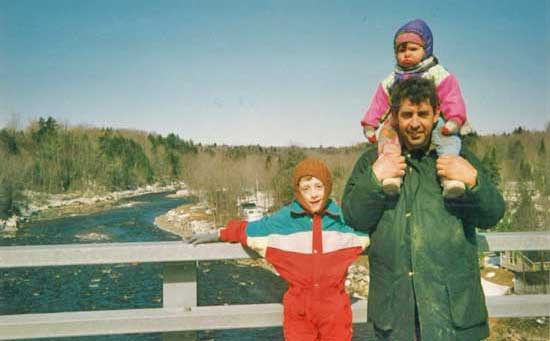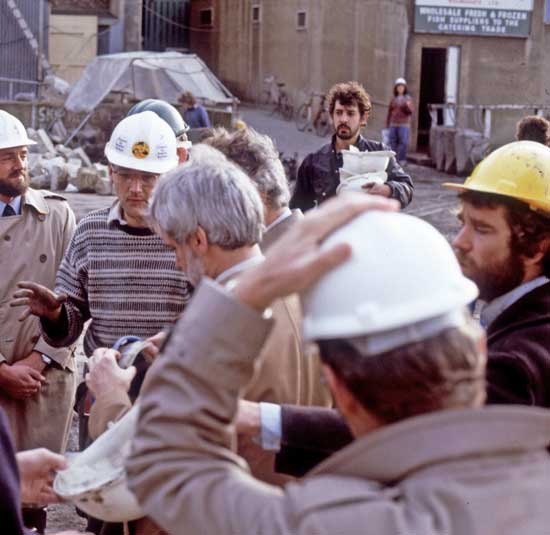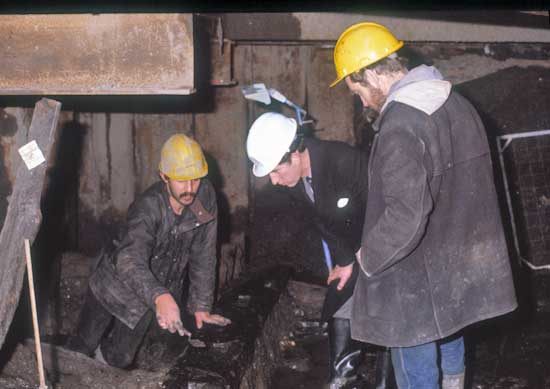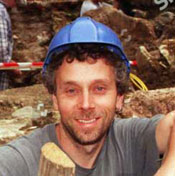Remembering a fallen ‘hero’: Chris Fenn (1958-2022)
Ian Blair
 Chris and his new life in Canada in 1992 with his daughter Camille on his shoulders and nephew Tom at his side. Tom is sister Julie Flude’s son. Julie was also a fellow DUA archaeologist. Photo: Julie Flude
Chris and his new life in Canada in 1992 with his daughter Camille on his shoulders and nephew Tom at his side. Tom is sister Julie Flude’s son. Julie was also a fellow DUA archaeologist. Photo: Julie Flude
I’m not exactly sure when I first met Chris or indeed when he departed the DUA as it did not seem that he was around for more than a few years in the first half of the 1980’s. It is highly likely that I first encountered him in some City hostelry where the archaeologists from ongoing sites and specialist staff would gather in the evenings. I really got the chance to know him well and count him as a friend whilst working alongside him in the early months of the Billingsgate excavation (BIG82) in 1982. It was around that time that one day he arrived noisily on site on a black trail motorcycle, and I remember him riding it through the comparatively empty streets of the City of London on his journey to and from work in the months that followed.
At Billingsgate we were excavating a post-medieval warehouse in the south-west corner of the site, south of the remains of medieval St Botolphs Church, and I recall one weekend Chris and I standing open-mouthed as we watched a City of London Archaeological Society (COLAS) volunteer, who had been fastidiously trowelling a tiny area of soil, pull out an inscribed and dated gold memento mori ring. Despite a slight sense of grievance and loss on both of our parts, I think that we both realised that we might have missed this with the more frenetic and urgent method of earth removal that took place during the week: especially as at that time it was not routine for there to be a dedicated metal detectorist on site to scan our spoil.
Chris has already made it into two of my previous posts relating to the Billingsgate site, namely describing his collection of a sizeable amount of liquid mercury found trapped within the coursing of a brick foundation we were dismantling, which he painstakingly chased drop-by-drop into a finds bag with the point of his trowel:
https://digginglondon.org.uk/billingsgate-memories-or-mad-as-a-hatter
The second post relates to my more recent search in the MOLA slide archive for a photograph of Chris and his subsequent impromptu audience on site with Prince Charles: now King Charles III, who visited Billingsgate at a mid-point in the excavation:
 Chris on Billingsgate (back right) having started a small pop-up business selling safety helmets to the massing crowd prior to the arrival of Prince Charles. The photo also features archaeologists Derek Gadd and Steve Roskams. Photo: Jon Bailey ©MOLA
Chris on Billingsgate (back right) having started a small pop-up business selling safety helmets to the massing crowd prior to the arrival of Prince Charles. The photo also features archaeologists Derek Gadd and Steve Roskams. Photo: Jon Bailey ©MOLA
https://digginglondon.org.uk/the-man-who-would-be-king
 Chris, with His Royal Highness Prince Charles (Now promoted to King Charles III) and Steve Roskams on Billingsgate in 1982. Photo: Jon Bailey ©MOLA
Chris, with His Royal Highness Prince Charles (Now promoted to King Charles III) and Steve Roskams on Billingsgate in 1982. Photo: Jon Bailey ©MOLA
My lasting memories of Chris are of one of the cheeriest individuals I have met, with a natural sense of fun, an infectious cheeky laugh, and invariably a ready dry quip to make. I well remember one occasion when I was heading down to Kent to see my folks who had a kennels and cattery with a veritable menagerie of assorted animals wandering around the place, that Chris asked if he could tag along. Our visit passed off uneventfully enough and we returned to London in the evening, with me as was customary on my visits home, carrying a box of free-range eggs laid by the hens that roamed freely around their five acres of land.
On our arrival back in London we headed north to Parkholme Road in Dalston, where Prince Chitwood resided and was the location of his local the ‘Prince George’. In the 1980’s this pub became a regular haunt for a group of DUA archaeologists, who would meet up and regularly play pool there on Saturday mornings. The licensees were John and I believe Elsie, both of whom had a fair-few miles on the clock, and who happily accepted their archaeological clientele, which in truth made up a fair amount of their custom as the pub was invariably pretty quiet.
On the evening that Chris and I arrived there from Kent, and it may well have been because there was a Whitbread Pool Tournament being held, which I somehow contrived to win and still have the tankard in a box somewhere to prove it, we all knew that we were destined for a lock-in that night. The tell-tale signs being if after John had opened up, Elsie arrived down at the bar, hair coiffured, lots of lipstick applied, and wearing a fancy dress.
Half a day later we staggered out as a new day dawned on the streets of Dalston and slowly weaved our way back to Haringey where I lived with Penny, somehow the eggs had miraculously managed to remain intact throughout: that was until Chris smashed one on my head. Given the unprovoked nature of this attack, it solicited a justifiable retaliatory strike and fifteen seconds later all the eggs were gone: three on my head and three on Chris’s. When we finally reached home an hour later, and desperately craving some shut-eye, we went straight to bed to sleep it off, leaving the now solidified egg residue in our hair to be washed out many hours later. I cannot remember if our hair was any better conditioned or shinier because of having had this impromptu treatment.
Today Sunday 4th of February 2024 would have been Chris’s 66th Birthday.
Rest in Peace Chris



Comments powered by CComment